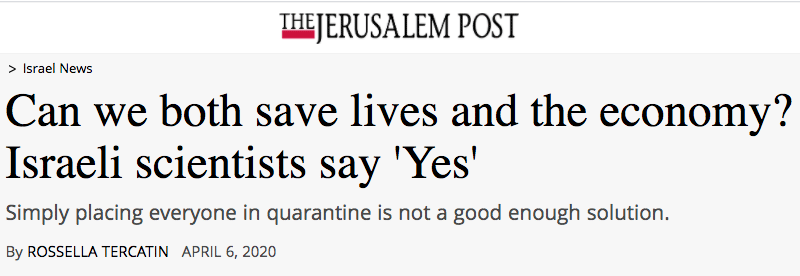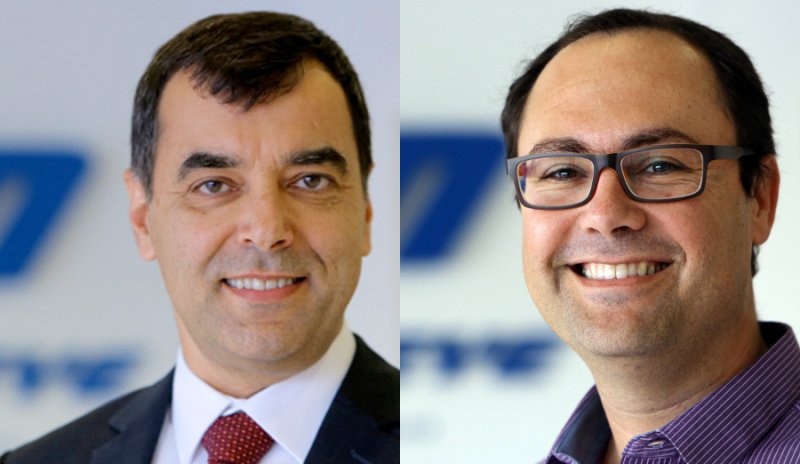

Can an anti-coronavirus strategy that saves lives and safeguards the economy at the same time be implemented? According to two computer scientists from the Hebrew University of Jerusalem, the answer is yes.
Professors Amnon Shashua and Shai Shalev-Shwartz serve as CEO and chief technology officer, respectively, of Mobileye. The Israeli start-up, which develops technology for self-driving cars, was acquired by Intel for more than $15 billion.
They published their proposal with the Center for Brains, Minds and Machines (CBMM) at MIT’s McGovern Institute for Brain Research.
They are working with the Israeli government to conduct further experiments to prove their theory, Shalev-Shwartz told The Jerusalem Post. If the results are as good, as they expect, their plan could become a part of the country’s exit strategy from the coronavirus emergency, he said.

Shalev-Shwartz explained why computer scientists are working on questions that seemingly should be addressed by epidemiologists.
“The type of thinking that computer scientists do deals with a lot of uncertainty,” he said. “We have a methodology for dealing with uncertainty by worst-case type of analysis. This means that we formulate a very basic assumption, and based on it we identify the worst-case scenario. If the worst-case scenario is not too bad, we are fine.”
This feature of computer scientists’ way of reasoning has come in handy with the coronavirus emergency, Shalev-Shwartz said.
“This is a new virus, and we do not know enough about it,” he told the Post. “But since we have the means to deal with uncertainty, we thought that our mathematical tools can be helpful.”
Shalev-Shwartz and Shashua based their strategy on the observation that the virus has been very dangerous for some people and not dangerous for others.
Because of this, the idea of placing everyone in quarantine is not an adequate solution, Shalev-Shwartz said.
“What is obtained this way is the flattening of the curve, which is good to avoid overloading the health system,” he said. “But it does not reduce the mortality. It only spreads across time.”
Their strategy is based on differentiating the measures for the high-risk group and for the low-risk group in a two-phase plan, Shalev-Shwartz said.
“In the first, the low-risk population, people younger than 65 and with no preexisting conditions can go back to a normal life, while the high-risk population keeps staying at home,” he said. “Within a period of about a month, the low-risk population will become immune to the virus because most of them will get infected.
“Many will not even notice, some will have minor effects, and few will have severe effects. This way, society will develop what it is called herd immunity, with people who had the virus not able to infect or be infected anymore.”
Once this is achieved, the at-risk population will be able to go back to a normal life “because if the rest of the population is immune, there will be no pandemic even if the elderly are out,” he added.
Their theory does not represent a way to merely slow the progression of the COVID-19, Shalev-Shwartz said.
“This is a complete solution to the problem because if the strategy is adopted, the overall mortality rate will be much lower,” he said.
There are two critical aspects for the solution to work, Shalev-Shwartz said.
“We can provide decision makers with a mathematical model to get the upper-bound number of severe cases among the low-risk population in the first phase so that they can decide if the health system can take care of them in intensive care,” he said. “The plan is viable only if it can.”
Moreover, a strict separation between the high- and low-risk population must be maintained, including for individuals from the two groups living in the same household, Shalev-Shwartz said.
“I believe that logistical solutions can be found,” he said. “The population needs to collaborate. But I think they would because we are talking about people who are quarantined to protect their own health.”
The government took the right decision in imposing a general lockdown on the country, Shalev-Shwartz said, because when the emergency began to emerge, it was important “to stop and to think it through.”
“However, now we need to understand how to end the lockdown,” he said. “I think that achieving herd immunity is a good idea, but it has to be done in a safe manner.”
That does not mean not caring about how many people are going to die or just how to protect the economy, Shalev-Shwartz said.
“One of the important messages that we are trying to convey is that this is not a trade-off between the economy and the safety of the population,” he said. “We believe that our proposal will not only be good for the economy, but it will actually save more lives than a uniform strategy for the entire population.”
“We are not in touch with the government and carrying out more studies,” Shalev-Shwartz said. “We hope to get the results in less than two weeks, right after Passover. We want to be careful. But if they are good, maybe this plan could be an important component of the exit strategy in Israel.”